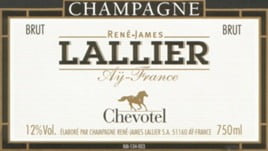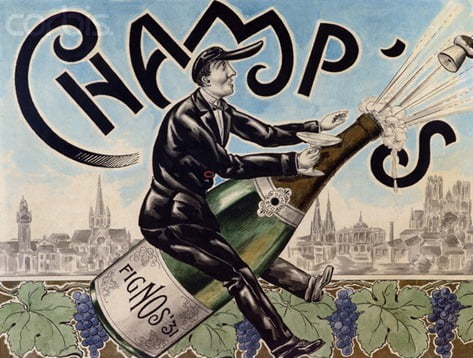Champagne Terms – You Need to be Drunk to Understand Them…
January 22, 2011 It’s no secret that all the different terms used to describe the production, style and quality is mind-numbing!
It’s no secret that all the different terms used to describe the production, style and quality is mind-numbing!
Here’s my guide to just about every term imaginable that you will ever find on a Champagne label.
Champagne / Sparkling Wine Dryness Levels
Brut Nature – You don’t see this used too much, but it means totally dry, no dosage (sweetening) added (less than 3 grams of sugar per liter)
Extra Brut (also less than 3 grams of sugar per liter)
Brut is dry, and the "standard" if you will. All the best Champagnes are labeled Brut (less than 15 grams of sugar per liter).
Extra-Dry is less dry than Brut, with a touch more dosage added (12-20 grams of sugar per liter)
Sec is sweet (17-35 grams of sugar per liter).
Demi Sec is even sweeter (33-50 grams of sugar per liter).
Doux will give you diabetes if you drink too much it’s so sweet (more than 50 grams of sugar per liter)!
 Champagne Terms
Champagne Terms
Here are some of the terms used to describe the way in which a particular bottle of Champagne was made. Stay with me on this because this is just about as confusing as wine will ever get! If you click on some of the pictures in this article they will enlarge, and you should be able to spot some of the small initials on the labels.
NM = Négociant Manipulant
A company that doesn’t grow any grapes (usually most of the large Champagne brands),but buys them from growers, and then make their own Champagne. Veuve Clicquot, Bollinger, Krug, Mumm, Pol Roger, Pommery, Piper Heidsieck, Perrier Jouet and Moët [Mo-wett] Chandon are all NM Champagnes.
CM = Coopérative de Manipulation.
A group of growers that get together and make Champagne from all their grapes being pooled together.
 RM = Récoltant Manipulant.
RM = Récoltant Manipulant.
Growers of grapes who also make their own Champagne. They can buy only 5% of grapes for their needs. The production of RM Champagnes tends to be small and of a high quality, but difficult to maintain from vintage to vintage.
SR = Société de Récoltants.
An association founded by two or more growers who share their vineyards and then sell their Champagne under more than one brand name.
RC = Récoltant Coopérateur.
A member of a group who is marketing by Champagne under their own label.
MA = Marque d’Acheteur.
A brand name unrelated to the producer or grower; the name is owned by someone else, for example a hotel.
ND = Négociant Distributeur.
A company or group that buys the Champagne already bottled and then simply sticks a label on it and then distributes.
So what does all this mean!?!?!
In theory RM and NM are the wines that are usually of a more reliable quality, but it’s not guaranteed. MA and ND are likely to be the most generic and inexpensive. The initials are likely to be stamped small on the front label of a bottle followed by the number of the producer (as in the pictures)
Other Champagne Terms Worth Noting…
Blanc de noir: Meaning white of black, in other words a white Champagne or Sparkling Wine made from black (Pinot Noir or Pinot Meunier) grapes. Although the "white of black" may sound like a contradiction, it is not. Champagne made from black grapes are typically full bodied and rich.
 Blanc de Blancs: A Champagne or Sparkling Wine made from only white grapes (usually Chardonnay, but there are exceptions). They are normally to be enjoyed young, and are relatively light, subtle and creamy. With a little aging these Champagnes often develop a rich and toasted flavor.
Blanc de Blancs: A Champagne or Sparkling Wine made from only white grapes (usually Chardonnay, but there are exceptions). They are normally to be enjoyed young, and are relatively light, subtle and creamy. With a little aging these Champagnes often develop a rich and toasted flavor.
Rosé: French word for pink wine, the word is in common use all over the world. This style wine is usually made by adding a little red wine to the white Champagne. However, sometimes it can be made by allowing the red grape skins to soak in the juice for a short period.
Non-Vintage: A Champagne made from a blend of wines from different years. Some Champagne houses may use up to a hundred different styles of wine to reach their "house blend".
Vintage: A Champagne made from a single year’s harvest of grapes. The label will show the year of the harvest and is normally only produced in the best years.
Cuvée: A French term used to denote a specific blend or batch of wine. It originates from the French word cuve meaning "vat". The word cuvée may also be used in terms such as "vin de cuvée", "cuvée speciale", or "tête de cuvée" to juice received from a first pressing of grapes. This is believed to be the best quality wine.
Now if you understand all of that you’ve earned a glass of the bubbly stuff!!!
This entry was posted in Facts, News. Bookmark the permalink. ← Is Wine the Same as Pot or Cigarettes? Top 10 Mistakes Wineries (and Other Businesses) Make on Facebook – Part 1 →











